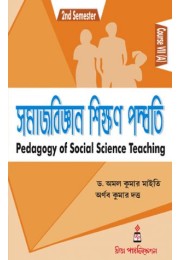UNDERSTANDING DISCIPLINE AND SUBJECTS (CC-5)
Rs.323.00Rs.340.00
Author: Dr. Mita Banerjee And Pranaya Pandey
Availability: In Stock
Publisher: Rita Publication

1. Discipline and Subject
1.1. Nature and Characteristics of Discipline
1.1.1. Meaning of Discipline
1.1.2. Definition of Discipline
1.1.3. Historical Perspective of Discipline
1.1.4. Nature of Discipline
1.1.5. Characteristics of Discipline
1.1.6. Discipline and Other Related Terms
1.1.7. Evolution of Discipline
1.1.8. Classifications of Disciplines
1.1.9. Approaches of Discipline
1.1.10. Relation and Difference Between School Subjects and Academic Discipline
1.1.11. Paradigm Shifts in Education
1.1.12. Discipline Specific Knowledge
1.1.13. Disciplinary Knowledge and Pedagogical Approaches in School Subjects
1.1.14. Pedagogical Approaches for Transacting Disciplinary Knowledge at different stages of School Education
1.1.15. Education is a Process
1.2. Education as Inter-disciplinary Field of Study
1.3. Emergence of Various Disciplines from Education
1.4. Merger of Various Disciplines into Education
1.5. Interrelation and Interdependence among Various School Subjects
2. Science as a Subject and Discipline
2.1. Nature and History of Science
2.1.1. Definition of Science
2.1.2. Characteristics of Science
2.1.3. Aims of Teaching Science
2.1.4. Objectives of Teaching Science
2.1.5. Nature of Science
2.1.6. Scope of Science
2.1.7. History of Science
2.1.8. Different Branches of Science
2.1.9. Values of Teaching Science
2.1.10. Need and Significance of Science
2.2. Place of Science in School Curriculum
2.3. Science in Day-to-day life
2.4. Relationship of Science with Other School Subjects
2.4.1. Relationship or Correlation of Science with One Another
2.4.2. Relationship or Correlation of Science and Other School Subjects
2.4.3. Relationship or Correlation of Science with Day to Day Life or Environment
3. Language as a Subject and Discipline
3.1. Concept of Language
3.1.1. Meaning of Language
3.1.2. Definitions of Language
3.1.3. Nature of Language
3.1.4. Characteristics of Language
3.1.5. Scope of Language
3.1.6. Aims and Objectives of Teaching Language
3.1.7. Functions of Language
3.1.8. Structure of Language
3.1.9. Significance of Language in Human Life
3.1.10. Misconceptions about Language
3.2. Centrality of Language in Education
3.3. Essentiality of Language in Education
3.4. Role of Language in Children’s Intellectual Development and Learning
3.4.1. Role of Language in Intellectual Development
3.4.2. Role of Language in Emotional Development
3.5. Language in School Curriculum
3.6. Policy Issues and Language at School
3.7. Language as a medium communication
3.7.1. Concept of Communication
3.7.2. Features of Effective Communication
3.7.3. Barriers to Effective Communication
3.7.4. Important Measures to Overcome Barriers of Effective Communication
3.7.5. Language as a Medium of Communication
3.8. Theories of Language Development
3.8.1. Chomsky’s View on Language Development
3.8.2. Piaget’s View on Language Development
3.8.3. Vygotsky’s View on Language Development
3.8.4. Problems Related to Language Development
3.8.5. Roles of Teacher in Language Development
3.9. Phases of language development
4. Mathematics as a Subject and Discipline
4.1. Nature and History of Mathematics
4.1.1. Definition of Mathematics
4.1.2. Characteristics of Mathematics
4.1.3. Aims of Teaching Mathematics
4.1.4. Objectives of teaching Mathematics
4.1.5. Nature of Mathematics
4.1.6. Scope of Mathematics
4.1.7. History of Mathematics
4.1.8. Contribution of Some Great Indian Mathematicians
4.1.9. Different Branches of Mathematics
4.1.10. Values of teaching Mathematics
4.1.11. Need and Significance of Mathematics
4.2. Place of Mathematics in School Curriculum
4.3. Mathematics in Day-to-day life
4.4. Relationship of Mathematics with Other Subjects
4.4.1. Kinds of Correlation in Mathematics
4.4.1.1. Correlation between different branches of Mathematics
4.4.1.2. Correlation between different topics of Mathematics
4.4.1.3. Correlation of Mathematics with the Other Subjects
5. Social Science as a Subject and Discipline
5.1. Nature and Philosophy of Social Science
5.1.1. Definition of Social Science
5.1.2. Philosophy of Social Science
5.1.3. Aims of Social Science
5.1.4. Objectives of Social Science
5.1.5. Origin of Social Science
5.1.6. Characteristics of Social Science
5.1.7. Nature of Social Science
5.1.8. Scope of Social Science
5.1.9. Various Disciplines of Social Sciences
5.1.10. Need of Social Science
5.1.11. Significance of Social Science
5.1.12. Values of Social Science
5.1.13. Similarities and Difference between Social Science and Social Studies
5.2. Social Science as an Area of Study
5.3. Need of Studying Social Science through Interdisciplinary Perspectives
5.4. Place and Relevance of Social Science in School Curriculum
5.4.1. National Perspective on
Social Sciences Curriculum
5.4.2. International Perspective on
Social Sciences Curriculum
5.4.3. Social Science as a Core Subject
5.4.4. Reasons for Social Science as a Core Subject
5.4.5. Social Science as a Subject in Indian School Curriculum
5.4.6. Relevance of Social Science in School Curriculum at Different levels
Practicum
References


















